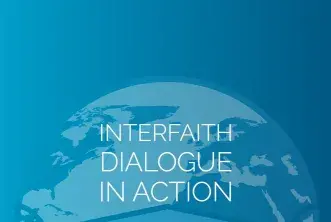Interfaith dialogue is more important than ever before, concludes a new KAICIID guide offering practical advice on the fostering of cross-community cooperation and joint action amid a pandemic.
The emergence of COVID-19 has stymied interreligious initiatives globally, precipitated an increase in xenophobia and stigmatisation, and fragmented efforts to promote tolerance and peaceful coexistence. At the same time, the pandemic has heightened the need for interfaith collaboration.
“A multi-faith approach to COVID-19 is essential,” said Professor Mohammed Abu-Nimer, Senior Adviser at KAICIID and joint author of the guide.
“The stress, the lack of resources, the uncertainty, as well as the pain and the sense of victimhood associated with the pandemic cannot be addressed by one faith group, or one government official. The virus does not distinguish between a Muslim, a Christian, a Jew, a Hindu, or a Buddhist,” he added.
The guide, titled ‘Interfaith Dialogue in Action. A Guide For Dealing With COVID-19’, seeks to catalyse creative thinking among faith groups, helping them develop multilateral strategies to better deal with challenges associated with the virus.
Crucially, the advice offered is globally relevant — a recognition that the pandemic exists beyond geographical, theological, and social boundaries.
“The guide is not regionally oriented, and it is not a case study. It has examples and recommendations that can be applicable to any context in the world, to any religious community that is open to dialogue,” said Dr. Aleksandra Djurić Milovanović, one of the document’s key architects.

The team adopted a two-pronged approach while developing the guide’s contents. First, a rigorous overview of existing resources on interfaith COVID-19-related action was conducted, examining the work of different non-governmental and religious organizations in the face of the pandemic.
Secondly, surveys were sent to dozens of KAICIID International Fellows to ascertain their response to the crisis, while a series of online discussions involving over a hundred Fellows from four regions served a similar purpose.
The information gleaned from these sessions was distilled down into a number of core recommendations, each accompanied by practical examples.
First and foremost, the guide underscores the importance of establishing interfaith and cross-sector partnerships. This, in a practical sense, could include organizing cross-community public prayers, issuing joint statements signalling solidarity, or collaborating on relief activities.
Recognising the wealth of successful private sector initiatives during the pandemic, the guide then recommends the seeking out of private sector promotion of interfaith activities, being mindful to always ensure that the interfaith message is appropriately reflected.
The use of social media and targeted campaigning to engage with young people and women’s networks are the guide’s third and fourth recommendations, citing examples of South Asian students writing digitally distributed essays on religious and cultural similarities, and interfaith home-schooling schemes embraced by women in Vienna.
The guide also recommends

the development of interreligious tools and the creation of so-called ‘one-stop shop’ online facilities, where individuals can access a host of COVID-19 resources in a single, virtual location.
Similarly, the guide reiterates the fundamental importance of utilising digital resources during the pandemic, urging faith groups to embrace new platforms for cross-community dialogue, like webinars, podcasts, and video consultations.
Likewise, the guide acknowledges the collaboration of faith-based organizations in moving rituals and practices online, including the worldwide ‘Prayer for Humanity’ which saw worshipers of all traditions come together in prayer in May.
The digital realm is also important in rooting out hate speech and countering misinformation, the guide explains, recommending the development of social media campaigns that challenge the rising tide of xenophobia and conspiracy theories.
Supporting local faith groups — and identifying their needs — particularly for those who lacked resources prior to COVID-19, and have thus been particularly hard-hit by the pandemic — should be a priority, too, the guide says, as should connecting society’s most needy with relief services.
The guide concludes with a series of questions for stakeholders to ponder, asking how interfaith organizations can ensure their continued flexibility, keep building relationships, address the lack of digital connectivity in a number of regions, and adapt to become more relevant in a time of COVID-19.


